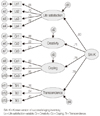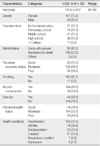Abstract
Purpose
The purpose of this study was to evaluate the reliability and validity of the Korean version of the Successful Aging Inventory (SAI-K) to determine its suitability for use with older Korean adults.
Methods
Exploratory and confirmatory factor analyses were utilized to assess the factor structure and the construct validity of the SAI-K. First- and second-order Confirmatory Factor Analysis (CFA) were conducted to identify the most adequate model. Cronbach's alpha was used to test the reliability.
Figures and Tables
References
1. An JS, Chong YS, Jeong YJ, Seo SG, Cooney TM. Critical aspirations from studies of successful aging. Korean J Dev Psychol. 2011; 24(3):35–54.
2. Bae BR. Structural equation modeling with Amos 17.0: Principles and practice. 2nd ed. Seoul: CheongRam Books;2009.
3. Cheon JS, Byun IW, Song HR, Oh BH. Factors related to the morale of Korean elders. J Korean Geriatr Psychiatry. 2004; 8(1):56–62.
4. Depp CA, Jeste DV. Definitions and predictors of successful aging: A comprehensive review of larger quantitative studies. Am J Geriatr Psychiatry. 2006; 14(1):6–20. http://dx.doi.org/10.1097/01.JGP.0000192501.03069.bc.
5. Eun Y, Sohng KY, Park OJ, Ko SH, Park MH, Kim JS, et al. Advanced clinical gerontological nursing. 2nd ed. Seoul: Hyunmoonsa;2010.
6. Field A. Discovering statistics using SPSS. 3rd ed. London, UK: Sage Publications Ltd;2009.
7. Flood M. Successful aging: A concept analysis. J Theory Constr Test. 2002; 6(2):105–108.
8. Flood M. A mid-range nursing theory of successful aging. J Theory Constr Test. 2005; 9(2):35–39.
9. Flood M, Scharer K. Creativity enhancement: Possibilities for successful aging. Issues Ment Health Nurs. 2006; 27(9):939–959. http://dx.doi.org/10.1080/01612840600899832.
10. Grove SK, Burns N, Gray JR. The practice of nursing research: Appraisal, synthesis, and generation of evidence. 7th ed. St. Louis, MO: Elsevier Inc;2012.
11. Hair JF, Tatham RL, Anderson RE, Black W. Multivariate data analysis. 5th ed. Upper Saddle River, NJ: Prentice Hall;1998.
12. Han SS, Lee SC. Nursing and health statistical analysis. Seoul: Hannarae Publishing Co;2012.
13. Harrington D. Confirmatory factor analysis. New York, NY: Oxford University Press Inc;2009.
14. Kim DB. The study on the development of the Korean elderly's successful aging scale. Korean J Soc Welf. 2008; 60(1):211–231.
15. Kim EJ, Kim Y. Predictors of successful aging in Korean older women based on successful aging theory (SAT). Korean J Women Health Nurs. 2011; 17(4):378–387. http://dx.doi.org/10.4069/kjwhn.2011.17.4.378.
16. Kim MH, Shin KR. The study on the development of the 'successful aging' scale for Korean elderly. J Korea Gerontol Soc. 2005; 25(2):35–52.
17. Kline RB. Principals and practice of structural equation modeling. New York, NY: Guilford Press;1998.
18. Lee EO, Lim NY, Park HA, Lee IS, Kim JI, Bae JY, et al. Nursing research and statistical analysis. 4th ed. Paju: Soomoonsa;2009.
19. Munro BH.
EH Lee
Y Chung
JS Kim
R Song
KY Hwang
. Statistical methods for health care research. 4th ed. Philadelphia, PA: Lippincott Williams & Wilkins;2001.
20. Nunnally JC, Bernstein IH. Psychometric theory. 3rd ed. New York, NY: McGraw-Hill;1994.
21. Reed PG. Self-transcendence theory. In : Smith MJ, Liehr PR, editors. Middle range theory for nursing. New York, NY: Springer Publishing Company, LLC;2008. p. 105–130.
22. Rowe JW, Kahn RL. Human aging: Usual and successful. Science. 1987; 237(4811):143–149.
23. Song JJ. SPSS/AMOS statistical analysis. 2nd ed. Paju: 21cbook;2012.
24. Song TM, Kim GS. Structural equation modeling for health & welfare research. Seoul: Hannarae Publishing Co;2012.
25. Troutman M, Nies MA, Small S, Bates A. The development and testing of an instrument to measure successful aging. Res Gerontol Nurs. 2011; 4(3):221–232. http://dx.doi.org/10.3928/19404921-20110106-02.
26. Van Prooijen JW, Van der Kloot WA. Confirmatory analysis of exploratively obtained factor structures. Educ Psychol Meas. 2001; 61(5):777–792. http://dx.doi.org/10.1177/00131640121971518.
27. Yu JP. Structural equation models: Concepts and understanding. Seoul: Hannarae Publishing Co;2012.




 PDF
PDF ePub
ePub Citation
Citation Print
Print







 XML Download
XML Download